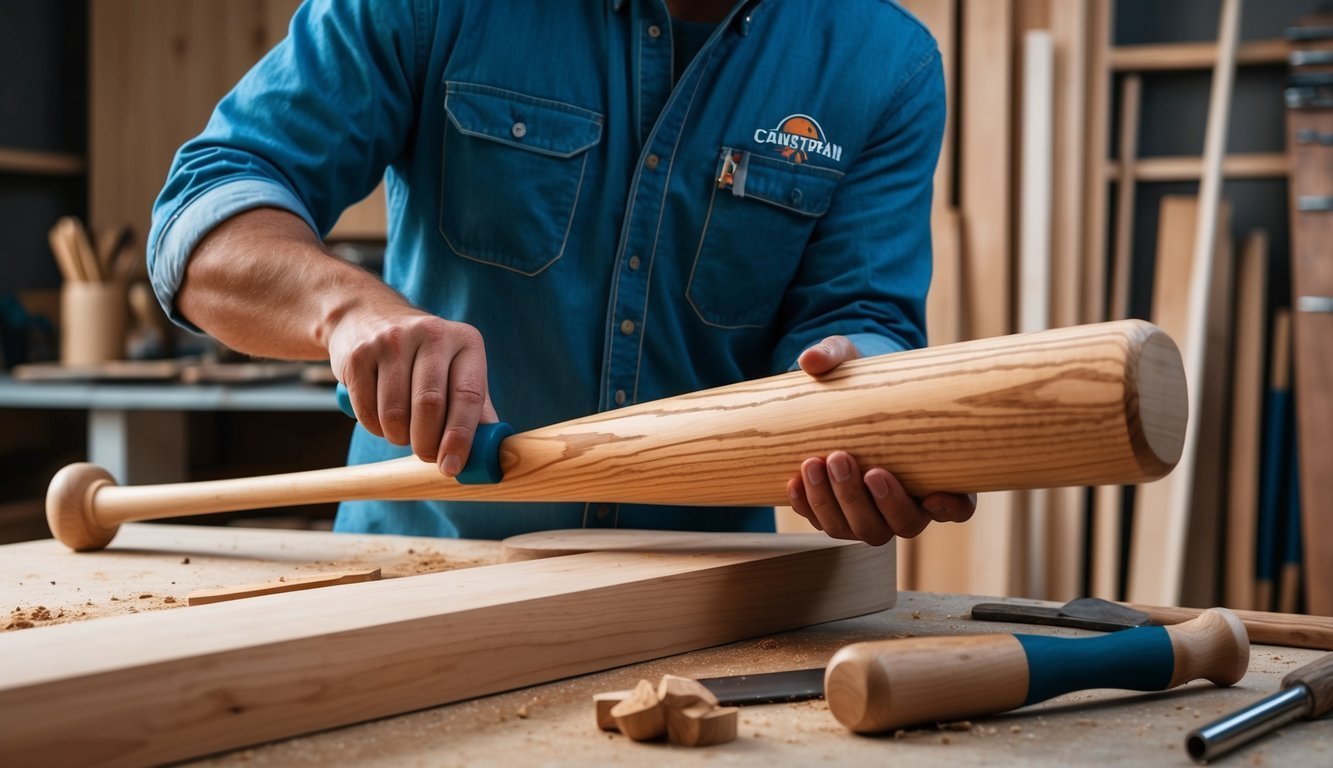Baseball bats have been an iconic part of America’s favorite pastime for generations.
The crack of the bat as it connects with a fastball is a sound that resonates with fans and players alike.
But have you ever wondered what these essential tools of the game are made from?
Most professional baseball bats are crafted from three main types of wood: maple, ash, and birch. Each type of wood offers unique characteristics that can affect a player’s performance at the plate.
Maple bats are known for their density and hardness, which can result in more powerful hits.
Ash bats, on the other hand, are prized for their flexibility and larger sweet spot.
The choice of wood for a baseball bat can vary depending on a player’s preferences and hitting style.
Some batters swear by the traditional feel of ash, while others prefer the pop of a maple bat.
Birch has gained popularity in recent years as a middle ground between maple and ash, offering a good balance of durability and flex.
Regardless of the type of wood used, crafting a high-quality baseball bat requires skill, precision, and a deep understanding of the game.
History and Evolution of Wood in Baseball
Wooden bats have been central to baseball since the sport’s inception.
Their development mirrors the game’s progression, with various wood types shaping the hitting experience over time.
The Origin of Wooden Bats
In baseball’s early days, players crafted their own bats from whatever wood was available.
Wagon tongues and ax handles often served as makeshift “striker’s sticks. ” As the game grew more organized in the 1840s, players began experimenting with different wood types and shapes.
By the time the Civil War ended, the design of bats had evolved significantly, reflecting both innovation and the players’ preferences.
This era laid the foundation for what would become essential tools of the game, shaping not only the performance of players but also contributing to baseball history and legends.
As manufacturers began producing bats in standardized shapes and sizes, the stage was set for the legendary matchups and iconic moments that would define the sport in the years to come.
Ash became a popular choice due to its flexibility and light weight.
Players would often whittle their own bats, creating unique designs tailored to their preferences.
Transition to Modern Baseball Bats
The late 19th century saw the rise of professional bat makers.
Bud Hillerich, a young woodworker, carved a custom bat for Pete Browning in 1884.
This led to the creation of Louisville Slugger, now an iconic name in baseball.
Maple gained popularity in the 1990s, prized for its hardness and potential for greater exit velocity.
Birch emerged as a middle-ground option, offering a blend of flexibility and durability.
Today, MLB allows bats made from ash, maple, or birch.
Each wood type has its fans among players, who choose based on feel, durability, and performance characteristics.
Different Types of Wood Used in Bats
Baseball bats are crafted from various wood species, each offering unique characteristics that can affect a player’s performance.
The most common woods used are ash, maple, and birch, though other options exist as well.
Ash Bats
Ash has long been a popular choice for baseball bats.
It’s known for its flexibility and large sweet spot.
When a player makes contact with the ball, ash bats tend to flex slightly, creating a trampoline effect that can increase hit distance.
Ash bats are typically lighter than other wood types, making them easier to control during swings.
They’re great for contact hitters who prioritize bat speed and precision over raw power.
One drawback of ash is that it can flake or splinter over time with repeated use.
Players often need to replace ash bats more frequently than those made from harder woods.
Maple Bats
Maple has become increasingly popular in professional baseball over the past couple of decades.
It’s a dense, hard wood that provides excellent durability and power potential.
Maple bats have a tighter grain structure than ash, resulting in a harder hitting surface.
This can lead to increased exit velocity when contact is made with the ball.
The sweet spot on maple bats tends to be smaller than ash, but the overall bat is less prone to flaking or splintering.
Many power hitters prefer maple for its ability to drive the ball with authority.
Birch Bats
Birch offers a middle ground between ash and maple.
It combines some of the flexibility of ash with the hardness of maple, making it a versatile choice for many players.
Like ash, birch bats have some flex, which can help with bat speed.
They also share maple’s durability, resisting dents and maintaining their shape over time.
Birch bats often require a break-in period to reach peak performance.
As they’re used, the wood compresses and hardens, potentially improving their hitting characteristics.
Other Wood Varieties
While less common, some players opt for bats made from hickory or bamboo.
Hickory is extremely dense and durable but quite heavy, making it challenging to swing quickly.
Bamboo bats are actually engineered wood products, created by pressing bamboo strips together.
They offer excellent durability and consistency but aren’t allowed in professional play.
Some manufacturers experiment with other wood species or composite materials, always seeking the perfect balance of performance and durability for baseball bats.
The Craftsmanship of Wood Baseball Bats
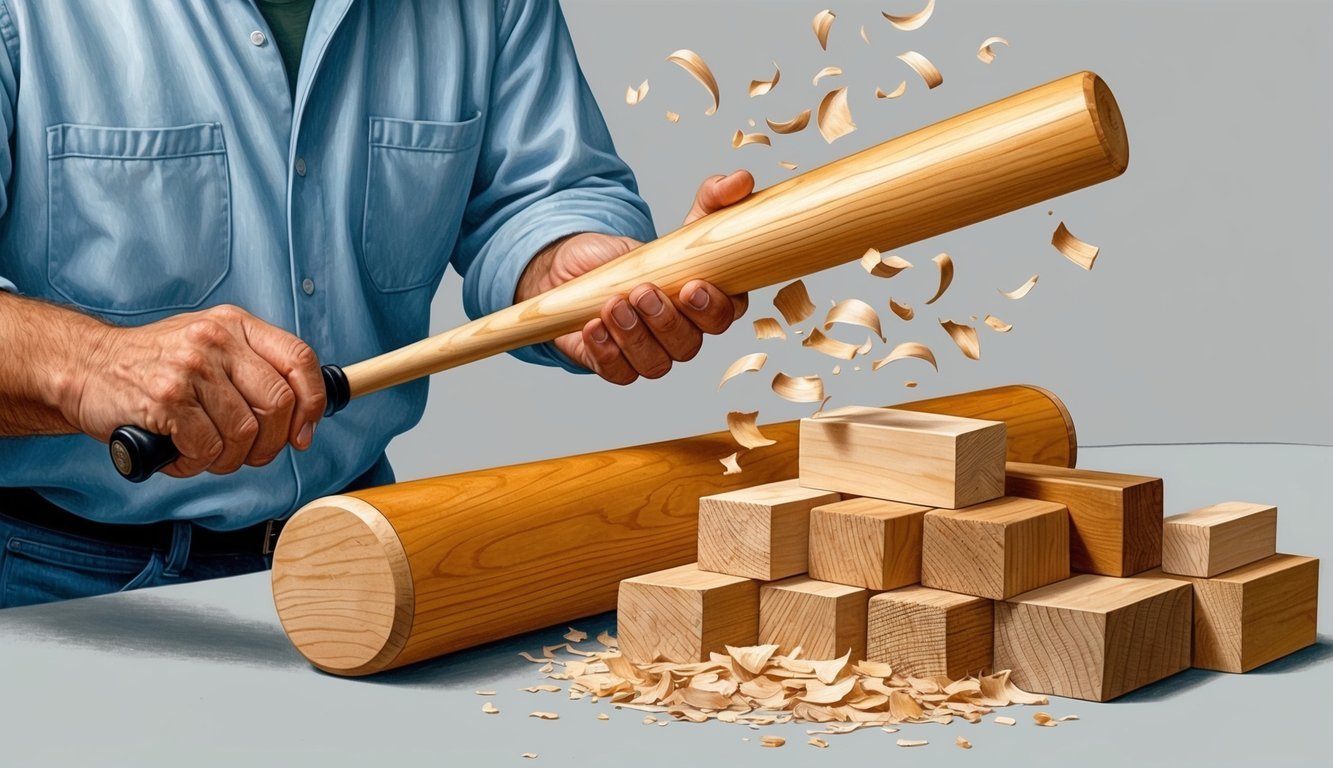
Creating a wood baseball bat is a meticulous process that combines traditional techniques with modern precision.
Skilled craftsmen transform raw wood into finely-tuned instruments of the game, paying attention to every detail along the way.
Selecting the Right Wood
The journey of a baseball bat begins with choosing the perfect wood.
Maple, ash, and birch are the most common choices for professional-grade bats.
Each wood type offers unique characteristics.
Maple is dense and hard, favored by power hitters for its solid feel on contact.
Ash provides flexibility and a larger sweet spot, making it popular among contact hitters.
Birch blends durability with flex, offering a middle ground between maple and ash.
Bat makers carefully inspect wood billets for straight grain patterns and absence of knots or imperfections.
They consider factors like wood density, moisture content, and weight distribution to ensure the bat meets specific performance standards.
From Billet to Bat
Once the wood is selected, the transformation begins.
Cylindrical billets are cut to length and placed on a lathe.
Skilled craftsmen shape the bat using computer-aided lathes for precise dimensions.
They carefully carve out the barrel, handle, and knob to match the desired specifications.
The bat’s weight, length, and balance point are meticulously controlled during this process.
Craftsmen constantly measure and adjust to achieve the perfect shape and weight distribution.
They may remove fractions of an inch here and there to fine-tune the bat’s performance characteristics.
Fine-Tuning and Finishing Touches
After shaping, the bat undergoes several finishing steps.
Sanding smooths the surface and refines the bat’s contours.
Multiple rounds of sanding, starting with coarse grit and progressing to fine, create a sleek, splinter-free surface.
Next comes the application of finishes or paint.
Some players prefer a natural wood look, while others opt for colored bats.
Regardless of the finish, multiple coats are applied to protect the wood and enhance its appearance.
The final steps include branding and labeling.
Bats receive the manufacturer’s logo, model number, and often the player’s name.
For MLB bats, this process may involve water decals for a professional look.
Factors Influencing Bat Performance
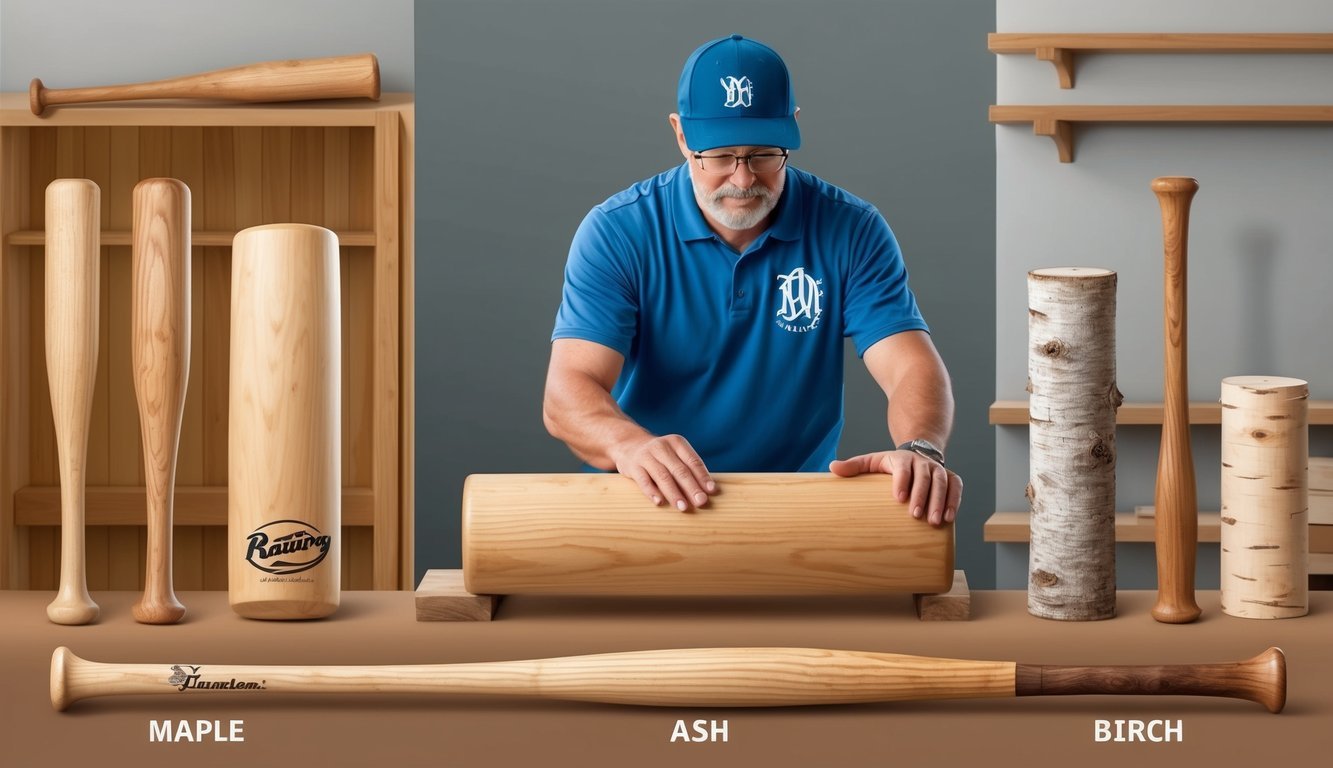
Several key elements impact how a baseball bat performs on the field.
These factors can make a significant difference in a player’s swing and hitting ability.
Weight and Balance
A bat’s weight and balance play crucial roles in performance.
Lighter bats allow for faster swings, potentially increasing bat speed.
Heavier bats can generate more power but may slow down swing speed.
The balance point affects how the bat feels in a player’s hands.
End-loaded bats have more weight toward the barrel, while balanced bats distribute weight more evenly.
Players often choose based on their hitting style and strength.
Bat manufacturers fine-tune these aspects to create optimal performance for different types of hitters.
Grain Structure and Durability
Wood grain structure significantly impacts bat durability and performance.
Straight, tight grains typically indicate stronger wood that’s less likely to break.
Maple bats often feature a dense, hard structure that can provide excellent power.
Ash bats tend to have a more flexible grain, offering a larger sweet spot.
Birch combines some qualities of both maple and ash, providing a balance of hardness and flex.
Players may choose different wood types based on their hitting preferences and the bat’s expected lifespan.
Moisture Content
The amount of moisture in a wooden bat affects its performance and durability.
Bats with proper moisture content maintain their strength and flexibility.
Too much moisture can make a bat heavy and prone to breaking.
Too little can cause the wood to become brittle and crack easily.
Manufacturers carefully control moisture levels during production.
Players should store their bats in climate-controlled environments to maintain optimal moisture content.
Proper care ensures the bat performs consistently over time.
Overall Design and Feel
A bat’s design encompasses various elements that influence its performance.
The barrel size affects the hitting surface area.
Larger barrels may offer a bigger sweet spot but can impact swing speed.
Handle thickness and taper affect grip and control.
Thinner handles may allow for quicker wrist action, while thicker ones can provide more stability.
The transition from handle to barrel, known as the taper, influences weight distribution and feel.
Players often try different designs to find what feels most comfortable and effective for their swing mechanics.
Regulations and Standards in Baseball
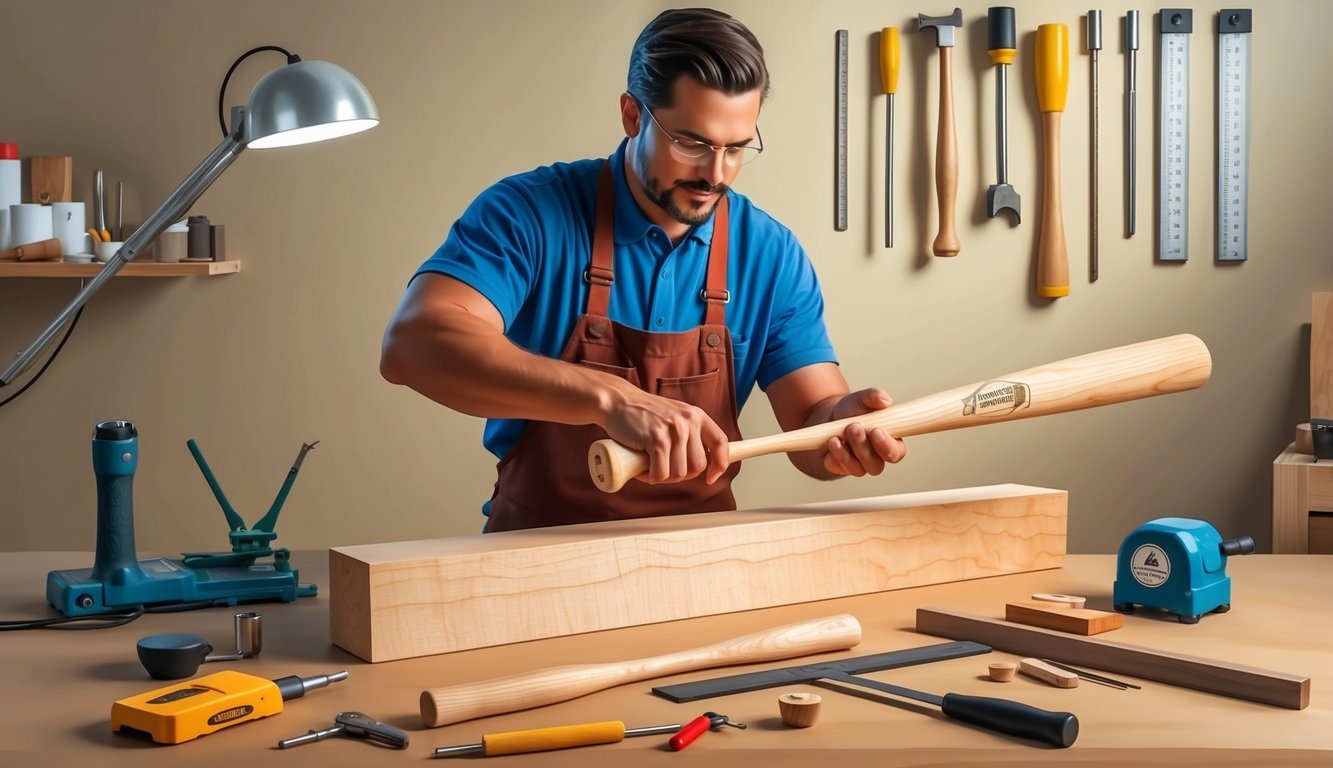
Baseball bat regulations ensure fair play and player safety across different levels of the sport.
Strict standards govern materials, dimensions, and performance.
Certification Requirements
Baseball bats must meet specific certification standards depending on the league and level of play.
BBCOR (Batted Ball Coefficient of Restitution) certification is required for high school and college baseball.
This standard limits the trampoline effect of metal bats, making them perform more like wood.
USA Baseball and USSSA certifications apply to youth baseball.
USA Baseball bats are designed for a more wood-like performance, while USSSA bats allow for a bit more pop.
Little League has its own bat regulations, which align closely with USA Baseball standards.
Certification logos must be visible on approved bats.
Players and coaches should always check for proper certification before using a bat in official games.
Professional and Amateur Use
MLB requires all bats to be made of solid wood.
Maple, ash, and birch are the most common woods used.
Composite bats are not allowed in professional play.
Amateur leagues have more varied regulations.
High school and college players use BBCOR-certified metal or composite bats.
Youth leagues may allow aluminum, composite, or wood bats, depending on their specific rules.
Wood composite bats, which blend wood and synthetic materials, are sometimes permitted in amateur play but not in professional games.
These bats aim to combine the traditional feel of wood with enhanced durability.
Bat regulations often specify maximum length (usually 42 inches) and barrel diameter (typically 2 5/8 inches).
Weight-to-length ratio restrictions also apply in many leagues to maintain fair play and player safety.
Choosing the Right Bat for Your Game
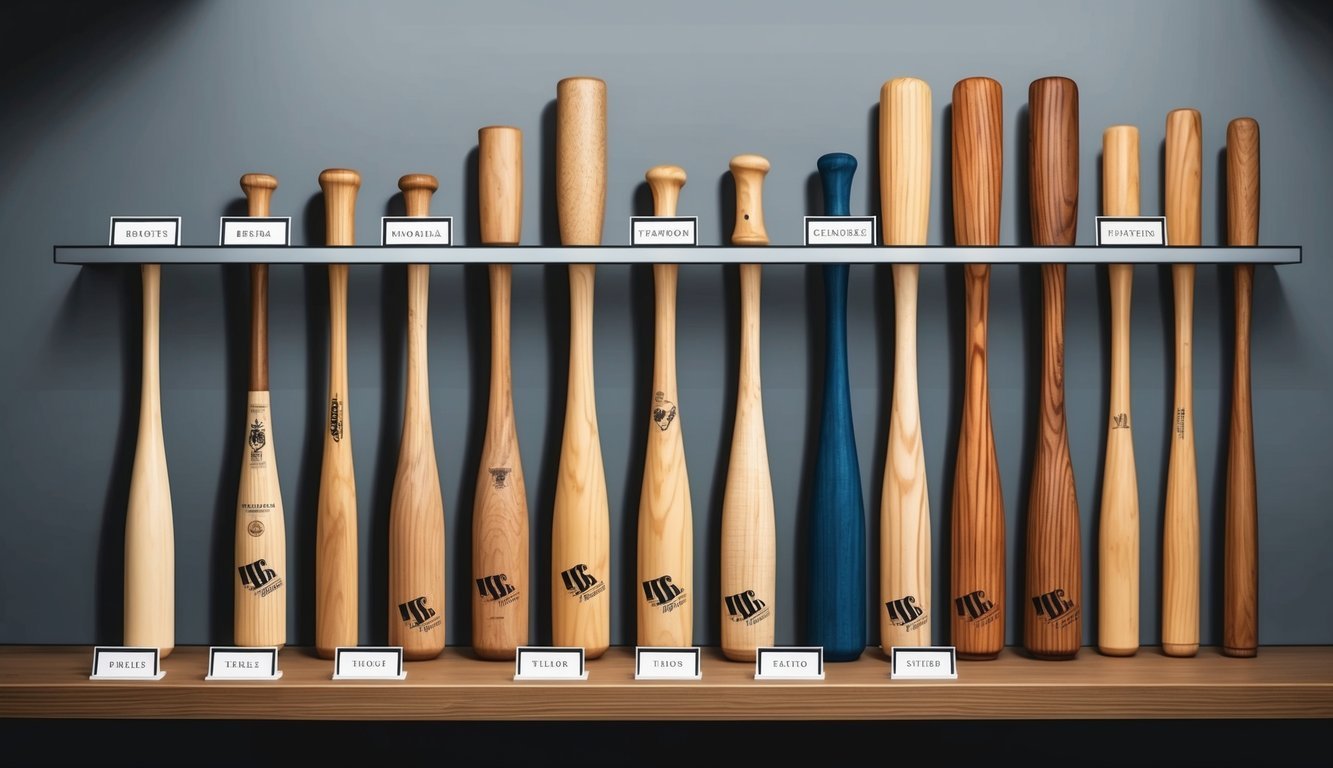
Selecting the perfect baseball bat involves considering your play style, hitting approach, and personal preferences.
The right bat can elevate your performance on the field.
Considering Your Play Style
Your batting technique and position in the lineup influence bat selection.
Leadoff hitters often prefer lighter, more maneuverable bats for quick swings and bat control.
Middle-of-the-order sluggers may opt for heavier bats to generate more power.
Outfielders typically choose longer bats for extended reach, while infielders might favor shorter bats for quicker swings.
A player’s strength and swing mechanics also factor into the ideal bat length and weight.
Experimenting with different models during practice can help players find their sweet spot.
Contact Hitters vs. Power Hitters
Contact hitters focus on putting the ball in play consistently.
They often prefer:
- Lighter bats (28-30 oz)
- Balanced weight distribution
- Thinner handles for increased bat speed
Power hitters aim to drive the ball for extra-base hits.
Their preferences often include:
- Heavier bats (31-33 oz)
- End-loaded designs for increased momentum
- Larger barrel diameters for a bigger sweet spot
Some players fall between these categories and may benefit from a hybrid bat design.
The Importance of Personal Preferences
Comfort and confidence with a bat are crucial.
Factors to consider include:
- Grip feel and handle thickness
- Visual appeal and color schemes
- Brand loyalty or player endorsements
Players should test various bats to find what feels natural.
Many develop strong preferences for certain models or wood types over time.
Seeking advice from coaches or experienced teammates can provide valuable insights.
However, personal feel should ultimately guide the decision.
Investment and Care
Quality wood bats are an investment in performance.
Premium models offer enhanced durability and craftsmanship, with prices ranging from $50 to $200+.
Budgeting for multiple bats allows for rotation and extended lifespan.
Proper care extends bat life.
You should store your bat in a cool, dry place.
Also, use bat sleeves for protection.
Lastly, rotate hitting surfaces to distribute wear.
Regular inspection for cracks or damage prevents unexpected breakage during games.
With proper care, a well-chosen wood bat can be a trusted companion throughout a season or longer.
